Charaka Indriya Sthana 7th Chapter Pannaroopiya Indriyam
7th chapter of Charaka Indriya sthana deals about the signs of imminent death as indicated by the distortion of the image reflected in the pupil. The chapter name is Pannaroopiya Indriyam.

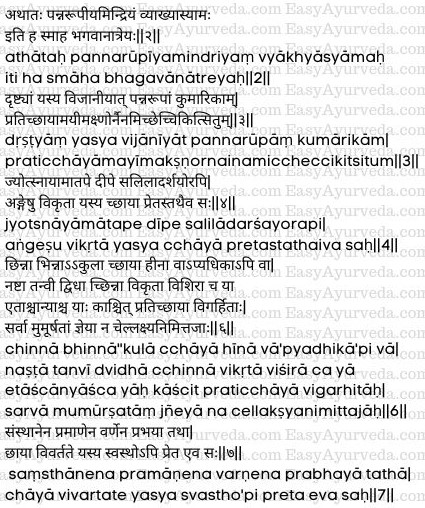
Now we shall expound the chapter on the signs of imminent death as indicated by the distortion of the image reflected in the pupil. Thus said lord Atreya [1-2]
Read – Arishta Lakshanas – Ominous Signs And Symptoms Indicating Bad Prognosis
Table of Contents
Shadow image in pupil
The physician should not treat the patient if any distortions are found in the shadow image in the pupil of the patient. [3]
Other types of shadow
The patient is considered as good as dead if there is any distortion in any part of the shadow of the body caused by moon- light, sunlight or the light of a lamp and of the image as reflected in the water or mirror. [4]
Read – Bad Prognosis Of Diseases Based On Dreams and Shadows
Distortions in shadow
Persons having shadows which are broken, split, hazy, devoid of certain organs, added with certain more organs, not conspicuous, bifurcated, deformed and without the head, and similar other shadows, without any visible cause, may be considered as moribund. [5-6]
A person whose shadow or reflected image changes in shape, measurement, colour and lustre, he is as good as dead even if he appears to be healthy. [7]
The term “samsthana” stands for shape. It might be even or uneven. Similarly measurement may be of three kinds – medium, short or large. The image reflected in water, mirror, sun etc. corresponding to the measurement and shape of the body of the individual is known as praticchaya. Pratichchaya is nothing but reflected shadow based on the colour and lustre of the individual. [8-9]
Read – Bad Prognosis Based On Smell, Touch, Taste, Colour And Voice

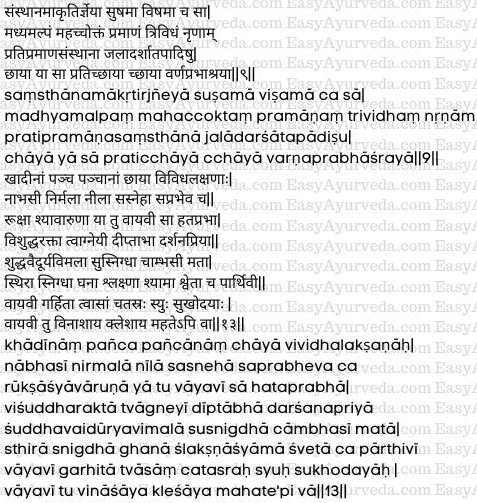
Mahabhutas and shadow
The following are the distinctive features of shadows relating to each of the five mahabhutas.
| Mahabhuta | Distinctive features of shadow | |
| 1 | Akasa | Clear, blue , unctuous and lustrous |
| 2 | Vayu | Dry, brown, and aruna ( reddish) |
| 3 | Agni | Pure red, brilliant and pleasing to the eyes. |
| 4 | Jala | Clear like vaidurya (cat’s eye) and excessively unctuous. |
| 5 | Prthvi | Stable, unctuous, compact, smooth, black and white. |
Read – Panchamahabhuta: Application, Areas of Utility in Ayurveda treatment
The shadow pertaining to vayu is of inferior category whereas the remaining four are indicative of happiness. The former is indicative of great calamities and miseries. [10-13]
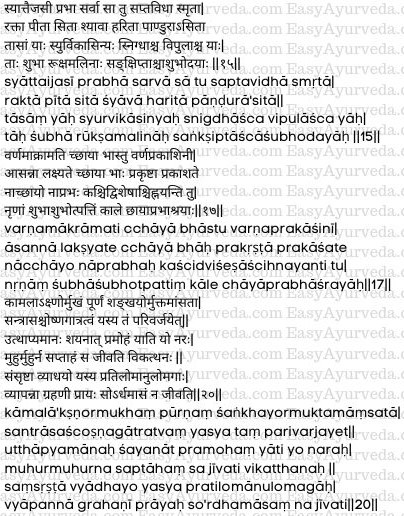
Various types of luster
All types of lustre are constituted of tejas mahabhuta i.e. fire element. They are of seven types, viz, red, yellow, white, brown, green, pandura (pale yellow) and black. Of them those which are emanative, unctuous and dense are auspicious. On the other hand, those which are dry, dirty and thin are inauspicious. [14-15]
Shadow vis a vis lustre
The chaya (shadow) circumscribes the complexion of the body whereas the prabha (lustre) illuminates the complexion. The shadow can be observed from nearby whereas the lustre illuminates from a distance. There is nothing devoid of shadow or lustre. Certain distinctive features of the shadow and the lustre when mature indicate emergence of auspicious or inauspicious results in respect of human beings. [16-17]
Read – Prognosis Signs Based On The Messenger – Doota Adhishtita Arishta
Signs of imminent death
- Yellowness of the eyes, swelling in the face, temples devoid of flesh, terrifying appearance and high temperature of the body (are the symptoms of imminent death) Patients with such symptoms must not be treated.
- A patient who faints again and again while being taken out of the bed cannot survive even for a week.
- A patient who suffers from diseases caused by more than one dosha in which both the upward and downward tracks are afflicted and whose grahani (duodenum and other parts of small intestine) are deranged cannot survive longer than a fortnight. [18-20]
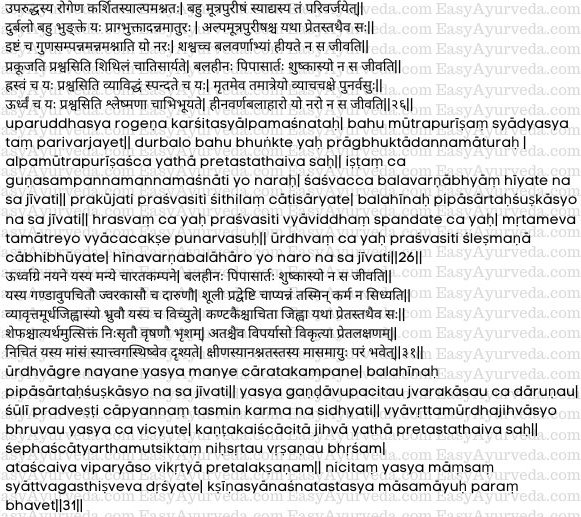
Read – How To Make Prognosis Of Disease According To Ayurveda?
- An emaciated patient, who takes very little food but passes urine and stool in large quantity, should not be treated.
- A weak patient who takes food which is more in quantity than his previous meal(s) but passes urine and stool in small quantity should be considered as already dead.
- If a person who is weak, thirsty and having dryness of mouth, suffers from groaning, dyspepsia and diarrhoea, then he does not survive.
- If the person is short of breath and there are irregular movements in his body, then according to Punarvasu Atreya, he does not survive.
- If a person, whose complexion, strength and capacity of intake of food are diminished, develops respiratory dyspnea and gets afflicted with kapha, then he does not survive. [21-26]
- If a person who is weak, thirsty and having dryness of mouth suffers from rigid and upward look of the eyes and constant throbbing of the carotid region of the neck. He does not survive.
- If a person is having swollen cheeks from high fever and severe cough, cough, colicky pain and aversion for food, then no treatment will succeed in curing him.
- If there is distortion of the head, tongue and face, drooping of the eyebrows and appearance of thorny coating over the tongue, then such a person should be considered as already dead.
- If phallus gets excessively shrunken and the testicles hang excessively loose or vice versa, then the person having such abnormal signs should be considered as already dead.
- If an emaciated person who has wasting of muscle and who is reduced to skin and bones does not take food, his residual span of life is not more than one month. [27-31]
Read – Bad Prognosis Based On Premonitory Symptoms Of Disease – Purvarupiya Arishta
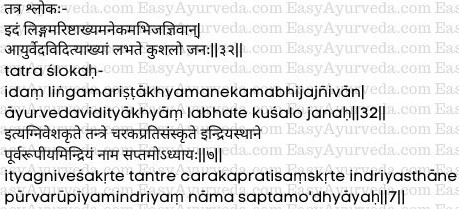
To sum up:- a wise person who is well versed with these various types of signs indicative of imminent death, is entitled to be called Ayurvedavit ( knower of the “science of medicine”). [32]
Thus ends the seventh chapter on the signs if imminent death as indicated by the “distortion of images reflected in the pupil” of the Indriya section of Agnivesha’s work as redacted by Charaka










